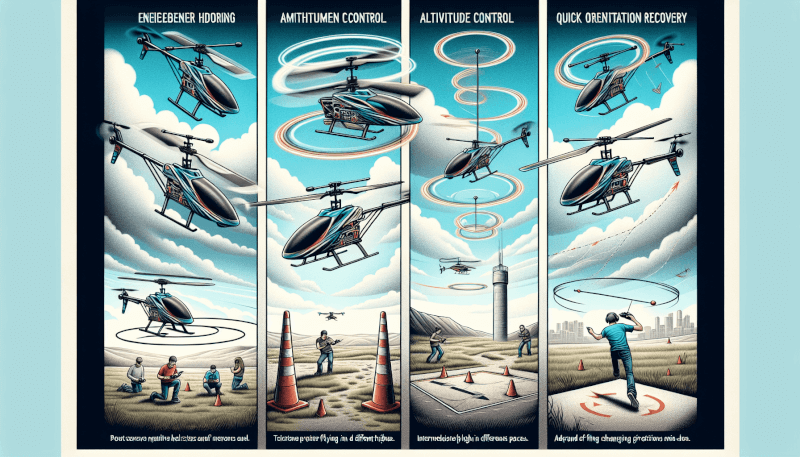Are you an RC helicopter enthusiast looking to improve your flying skills? Look no further! In this article, we will share with you the top 5 RC helicopter training exercises that are guaranteed to take your flying abilities to the next level. Whether you’re a beginner or an experienced pilot, these exercises will help you sharpen your technique, master new maneuvers, and gain better control over your RC helicopter. So buckle up and get ready to become a pro in no time!
Hovering Practice
Basic Hovering
When it comes to flying an RC helicopter, mastering the art of hovering is essential. Basic hovering refers to maintaining a stable position in the air, keeping the helicopter balanced and steady. To practice basic hovering, start by finding an open area with no obstacles and gently bring your helicopter up to a few feet in the air. Use small and precise adjustments to maintain your helicopter’s position. It may take some time and practice, but with patience and perseverance, you will improve your ability to hover confidently.
Hovering in Different Positions
Once you have mastered basic hovering, it’s time to expand your skills by practicing hovering in different positions. This exercise will help you become comfortable controlling the helicopter’s movement in various orientations. Start by hovering the helicopter with its nose facing away from you, known as the tail-in position. Then gradually progress to hovering with the nose pointed towards you, which is known as the nose-in position. This maneuver requires a different control inputs, so take your time, and practice each position until you feel comfortable and confident.
Hovering in Windy Conditions
It’s important to be able to handle real-world situations while flying an RC helicopter. Windy conditions can make hovering more challenging, but with practice, you can learn to manage it effectively. Start by practicing hovering on days with light to moderate winds, gradually increasing the difficulty as you gain confidence. When hovering in windy conditions, it’s important to anticipate the wind direction and make subtle control adjustments to counteract the wind’s effect on your helicopter. Keep practicing and honing your skills, and soon you’ll be able to confidently hover in all types of weather conditions.

Flying Figure Eight
Creating a Figure Eight Path
Flying a figure eight path is not only fun but also a great way to improve your flying skills. To practice this maneuver, start by imagining an imaginary figure eight in the air. Begin by flying towards yourself in a straight line, and as you approach the center of the imaginary figure eight, smoothly transition into a turn to the left or right. As you complete the first loop, continue flying in a straight line until you reach the opposite side of the figure eight. Then, transition into a turn in the opposite direction to complete the second loop. By practicing this exercise, you’ll improve your ability to navigate the helicopter through different flight paths.
Maintaining Stable Altitude
One of the key aspects of flying a figure eight is maintaining a stable altitude throughout the maneuver. This requires a combination of throttle control and precise stick inputs. As you fly through the turns, you may need to adjust the throttle to ensure a consistent altitude. Remember to make gradual throttle adjustments and anticipate how the helicopter will respond. With practice, you’ll be able to maintain a steady altitude and smoothly transition between turns, creating a fluid figure eight pattern in the sky.
Smoothly Transitioning Between Turns
To master the figure eight maneuver, it’s crucial to smoothly transition between turns without losing control of the helicopter. As you approach the center of the figure eight, gently apply the desired control input to initiate the turn. Avoid making abrupt movements, as this can lead to instability. Instead, focus on making precise and gradual movements to smoothly navigate through the turns. By practicing this skill, you’ll develop the ability to execute controlled turns and maintain control of the helicopter throughout the entire figure eight flight path.

Nose-in Hovering
Understanding the Orientation
Nose-in hovering is a challenging skill that requires a good understanding of the helicopter’s orientation. In this position, the front of the helicopter is facing towards you, which can be disorienting for beginners. To practice nose-in hovering, start by positioning yourself so that the helicopter is facing away from you. Slowly rotate the helicopter until the nose is pointed towards you, and then attempt to maintain a stable hover. This exercise will help you become more comfortable controlling the helicopter when it is in the nose-in position.
Controlling the Helicopter’s Movement
Once you have developed a basic understanding of the nose-in orientation, it’s time to focus on controlling the helicopter’s movement. When the nose is facing towards you, the control inputs are reversed compared to the tail-in position. This means that pushing the elevator stick forward will make the helicopter move towards you, and pulling the stick back will make it move away. Rudder inputs will also be reversed. Practice making small and precise stick movements to maintain a stable hover and gradually increase the difficulty as you become more proficient.
Gradually Increasing Difficulty
As with any new skill, it’s important to start with the basics and gradually increase the difficulty level. Once you have mastered nose-in hovering in a stationary position, challenge yourself by adding horizontal movement. Practice flying the helicopter in a line parallel to your viewing direction, then gradually introduce turns and figure eight patterns. By gradually increasing the difficulty, you’ll improve your overall control and become more comfortable with nose-in hovering in various flight scenarios.

Sideways Flying
Mastering the Side-to-Side Movement
Sideways flying is another essential skill that adds versatility to your flying abilities. To master this maneuver, start by hovering the helicopter in a tail-in position, with the nose facing away from you. Gently push the cyclic stick to the left or right to initiate sideways movement. Make small and precise adjustments to maintain a stable hover while moving laterally. It is important to pay attention to the helicopter’s orientation and make necessary control inputs to counteract any unwanted rotation during sideways flight. With practice, you’ll be able to confidently fly the helicopter in both forward and sideways directions.
Maintaining Steady Speed
Maintaining a steady speed during sideways flying is crucial to achieving smooth and controlled movements. By making constant and precise stick adjustments, you can control the helicopter’s speed and prevent it from drifting or accelerating too quickly. Focus on maintaining a consistent stick input while monitoring the helicopter’s position relative to the ground. Gradually increase your speed as you gain confidence, but remember to always prioritize stability and control over speed. With practice, you’ll be able to fly the helicopter sideways with grace and precision.
Avoiding Drift
One common challenge when flying sideways is dealing with drift, where the helicopter unintentionally moves forward or backward due to wind or other factors. To avoid drift, it’s important to make constant adjustments to the helicopter’s cyclic input. This will help counteract any external forces and keep the helicopter in its intended path. Pay close attention to the helicopter’s position and adjust the cyclic stick as needed to maintain a straight and controlled sideways flight. Through practice and experience, you’ll develop the skills necessary to fly sideways with minimal drift and improved accuracy.

Pirouettes
Executing Controlled Spins
Pirouettes are a dynamic maneuver that involves spinning the helicopter on its axis while maintaining control and stability. To execute pirouettes, start by hovering the helicopter at a comfortable height in a tail-in position. Gradually increase the rotor speed by adjusting the throttle until the helicopter starts to spin on its axis. Use rudder inputs to control the direction and speed of the spin. It’s important to make precise and subtle rudder movements to maintain control and prevent the helicopter from losing stability. With practice, you’ll be able to execute pirouettes smoothly and with precision.
Maintaining Balance and Altitude
Maintaining balance and altitude is crucial when performing pirouettes. The helicopter’s weight distribution can change during the spin, affecting its stability. Pay close attention to the helicopter’s attitude and make necessary cyclic inputs to counteract any tilting or leaning. Additionally, be mindful of the throttle control to ensure a stable altitude throughout the maneuver. By practicing and honing your skills, you’ll be able to maintain a balanced and controlled pirouette, impressing onlookers with your precision.
Increasing Speed and Precision
Once you have mastered the basics of pirouettes, it’s time to focus on increasing your speed and precision. Gradually increase the rotor speed to execute faster spins and challenge yourself to maintain control and stability. As you become more comfortable, experiment with different spin directions and combinations, such as consecutive pirouettes in opposite directions. Push yourself to achieve greater speed and accuracy while always prioritizing safety and control. With practice, you’ll develop the confidence to perform impressive and precise pirouettes that showcase your mastery of RC helicopter flying.
In conclusion, mastering these five training exercises will greatly improve your RC helicopter flying skills. Whether you are a beginner or an experienced pilot, practicing basic hovering, flying figure eights, nose-in hovering, sideways flying, and pirouettes will enhance your control, precision, and overall enjoyment of flying. Remember to take it one step at a time, gradually increasing difficulty as you gain confidence and proficiency in each skill. With dedication, practice, and a friendly attitude, you’ll soon become a skilled pilot capable of performing impressive aerial maneuvers with your RC helicopter. So, take to the skies and have fun honing your skills!



